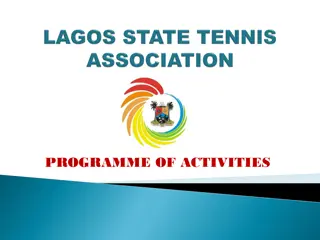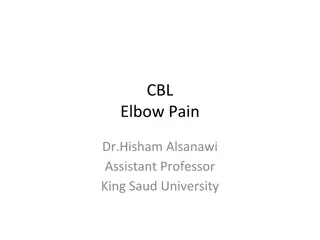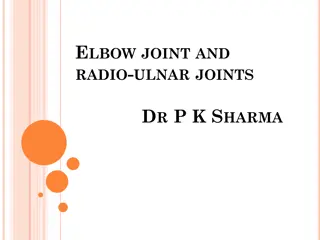Understanding Tennis Elbow: Causes, Symptoms, and Diagnosis
Tennis elbow, or lateral epicondylitis, is a painful condition caused by overuse, with symptoms including pain on the outside of the elbow that may radiate down the forearm. Activities like tennis, golfing, and repetitive wrist movements can trigger this condition. Common symptoms include elbow pain, weak grip, and pain when lifting objects. Diagnosis involves a physical exam and imaging tests to rule out other disorders.
Download Presentation

Please find below an Image/Link to download the presentation.
The content on the website is provided AS IS for your information and personal use only. It may not be sold, licensed, or shared on other websites without obtaining consent from the author. Download presentation by click this link. If you encounter any issues during the download, it is possible that the publisher has removed the file from their server.
E N D
Presentation Transcript
TENNIS ELBOW By: SUMAN KUMARI ASSISTANT PROFESSOR DEPARTMENT OF B. VOCATIONAL SPORTS NUTRITION AND PHYSIOTHERAPY KANYA MAHAVIDYALAYA KARKHODA
Introduction : Tennis Elbow Tennis elbow, or lateral epicondylitis, is a painful inflammation of the elbow joint caused by (overuse). The pain is located on the outside (lateral side) of the elbow, but may radiate down the back of your forearm. You ll likely feel the pain when you straighten or fully extend your arm. repetitive stress
Clinically Relevant Anatomy The elbow joint is made up of three bones: the humerus (upper arm bone), the radius and ulna (two bones in the forearm). At the distal end of the humerus there are two epicondyles, one lateral (on the outside) and one medial (on the inside). The area of maximal tenderness is usually an area just distal to the origin of the extensor muscles of the forearm at the lateral epicondyle. Most commonly, the extensor carpi radialis brevis (ECRB) is involved, but others may include the extensor digitorum, extensor carpi radialis longus (ECRL), and extensor carpi ulnaris. The radial nerve is also in close proximity to this region, and divides into the superficial radial nerve and the posterior interosseous nerve. Epidemiology/Aetiology
Causes Tennis elbow can be triggered by any activity that involves repetitive twisting of the wrist. These activities may include: tennis and other racquet sports swimming golfing turning a key frequently using a screwdriver, hammer, or computer
Symptoms You may experience some of the following symptoms if you have tennis elbow: elbow pain that is mild at first but gradually gets worse pain extending from the outside of the elbow down to the forearm and wrist a weak grip increased pain when shaking hands or squeezing an object pain when lifting something, using tools, or opening jars
Dignosis Tennis elbow is usually diagnosed during a physical exam. Your doctor will ask you about your job, whether you play any sports, and how your symptoms developed. They will then perform some simple tests to help make a diagnosis. Your doctor may apply some pressure to the spot where the tendon attaches to the bone to check for pain. When the elbow is straight and the wrist is flexed (bent toward the palm side), you ll feel pain along the outer side of the elbow as you extend (straighten) the wrist. Your doctor may also order imaging tests, such as an X- ray or MRI scan, to rule out other disorders that can cause arm pain. These include arthritis of the elbow. These tests are not usually necessary to make a diagnosis.
Tennis elbow treatment Rest Nonsteroidal anti-inflammatory medicines Physical therapy Ultrasound therapy Steroid injections
Physiotherapy Management Education/Advice- on pain control and/or modification of activities Exercises- Strengthening and Stretching Modalities- Ultrasound, Transcutaneous electrical nerve stimulation (TENS) Braces/Splints/Straps Medications- NSAIDs offer a short term benefit (3-4 weeks pain relief) Corticosteroids injection- Short term effect (6 weeks) Sport/Occupation Specific Rehabilitation























